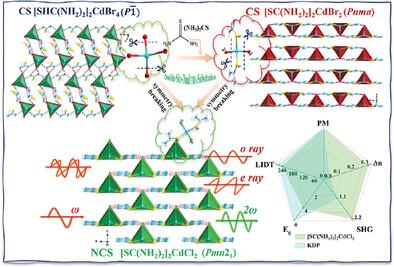Designing Polar Covalent Hybrid Cadmium-Based Chalcohalides Ultraviolet Nonlinear Optical Crystal with Strong Optical Anisotropy via Double-Site Dual FBUs Tailoring
IF 13
2区 材料科学
Q1 CHEMISTRY, MULTIDISCIPLINARY
引用次数: 0
Abstract
The pressing demand for both established and innovative technologies to expand laser wavelengths has rendered high-performance nonlinear optical (NLO) crystals with large optical anisotropy indispensable. Here, centrosymmetric [SHC(NH2)2]2CdBr4 (1) and pseudo-2D layered [SC(NH2)2]2CdBr2 (2), as well as pseudo-3D noncentrosymmetric [SC(NH2)2]2CdCl2 (3) are successfully synthesized through the introduction of π-conjugated SC(NH2)2 groups. Compared to ionic compound 1 containing full-halogen coordination tetrahedra, covalent compounds 2 and 3 featuring novel polar [SC(NH2)2]2CdX2 (X = Br, Cl) tetrahedral units demonstrate enhanced bandgaps (>4 eV) and birefringences (>0.3@546 nm) due to the unique coordination environment. Remarkably, 3 exhibits a strong second-harmonic generation (SHG) response (2.1 × KH2PO4(KDP)), high laser-induced damage thresholds (30 × AgGaS2(AGS), and excellent water stability. The birefringence of 3 is the largest among the hybrid halides NLO crystals containing d10 metal cations. Detailed theoretical calculations confirm that such a modified double-site dual functional building units (FBUs) substitution is an effective strategy for designing superior optical materials with large birefringence and strong SHG response, paving the way for the development of high-performance devices in related fields.

通过双位点双 FBUs 裁剪设计具有强光学各向异性的极性共价杂化镉基卤化物紫外非线性光学晶体
本文章由计算机程序翻译,如有差异,请以英文原文为准。
求助全文
约1分钟内获得全文
求助全文
来源期刊

Small
工程技术-材料科学:综合
CiteScore
17.70
自引率
3.80%
发文量
1830
审稿时长
2.1 months
期刊介绍:
Small serves as an exceptional platform for both experimental and theoretical studies in fundamental and applied interdisciplinary research at the nano- and microscale. The journal offers a compelling mix of peer-reviewed Research Articles, Reviews, Perspectives, and Comments.
With a remarkable 2022 Journal Impact Factor of 13.3 (Journal Citation Reports from Clarivate Analytics, 2023), Small remains among the top multidisciplinary journals, covering a wide range of topics at the interface of materials science, chemistry, physics, engineering, medicine, and biology.
Small's readership includes biochemists, biologists, biomedical scientists, chemists, engineers, information technologists, materials scientists, physicists, and theoreticians alike.
 求助内容:
求助内容: 应助结果提醒方式:
应助结果提醒方式:


